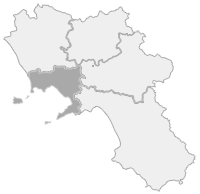With its 11,256 hectares, the one that protects the sea surrounding the Flegrean Islands is the largest of the Marine Protected Areas in Campania and one of the largest in Italy.
 It was precisely the great biodiversity of the Gulf of Naples at the origin of Anton Dohrn's choice to create in the city of Partenope the first of the research stations that he had planned to open on all continents, to study the seas and oceans of the planet. A context decidedly favorable to science that he had also found on Ischia and in fact in his holiday home, on the hill to the right of the port, the Villa Dohrn known since then as the Aquarium, regularly hosted scholars from all over the world active in the Neapolitan headquarters, offering them the opportunity to continue their research while on the island. Which is located in a particular geographical position, corresponding to a sort of "climatic border" between the northern and southern Mediterranean, where both the endemic species of the north and those of the south coexist permanently.
It was precisely the great biodiversity of the Gulf of Naples at the origin of Anton Dohrn's choice to create in the city of Partenope the first of the research stations that he had planned to open on all continents, to study the seas and oceans of the planet. A context decidedly favorable to science that he had also found on Ischia and in fact in his holiday home, on the hill to the right of the port, the Villa Dohrn known since then as the Aquarium, regularly hosted scholars from all over the world active in the Neapolitan headquarters, offering them the opportunity to continue their research while on the island. Which is located in a particular geographical position, corresponding to a sort of "climatic border" between the northern and southern Mediterranean, where both the endemic species of the north and those of the south coexist permanently.
However, it is not only the climatic element that determines the great plant and animal biodiversity that characterizes the Kingdom of Neptune. A decisive role is also played by the geomorphological characteristics of the seabed, where there are also shoals, particularly precious for the variety of populations that have settled there. Without forgetting that along the coast, partly submerged, there are also several caves, all rich in marine life.
Another favorable condition is the presence of both volcanic and sandy substrates. The rocky walls, both in the points most exposed to the light and in those more in the shade, are colonized by the most diverse species present in the Mediterranean: green and red algae to which the Caulerpa (of tropical origin) racemosa have been added permanently for some decades, taxifolia and prolifera and then sponges, bryozoans, madrepores, corals and gorgonians of brilliant colours. Formations of red coral resist both in Pizzaco, on the island of Procida, and on the volcanic rock wall of Sant'Angelo, on the island of Ischia, where there is also the rare Gerardia savaglia, known as false black coral. And around the coral there is a great wealth of algae, invertebrates and fish. In Pizzaco, for example, the calcified red algae create the ideal conditions for the settlement of countless other marine creatures.
Posidonia Oceanica
Another factor favorable to biodiversity is the presence in the Kingdom of Neptune, mainly on sandy but also rocky substrates, of luxuriant meadows of Posidonia oceanica, the marine plant typical of the Mediterranean, which almost entirely surround Ischia with a "green belt" which is interrupted only to the south and which then joins up with the Posidonia meadows of Vivara and Procida on which the perimeter of the Marine Area is "modelled". Covering a good 16 square kilometres, the plant grows both on rocky bottoms, such as at Punta Imperatore and Punta Caruso, and sandy ones, in front of the north and north-west coast, and on terraces of lignified roots and debris, such as at the Aragonese Castle, at Monte Vico and Punta San Pancrazio, going from a minimum depth of one meter (for example between the Castle and the bay of Sant'Anna) to 30 metres. Subject of monitoring and research since the second half of the seventies of the last century by the local Benthos Ecology Laboratory (now Ischia Marine Center) of the Zoological Station of Naples, the prairies of Ischia are the most studied in the Mediterranean, an open-air laboratory which has made it possible to considerably improve the knowledge of the plant, which makes a contribution to the marine environment comparable to that of the large tropical forests on land. In fact, it is a priority ecosystem that produces large quantities of oxygen; which with the matte forms a decisive barrier to protect the coasts from the erosion of the waves; which functions as a nursery and refuge for numerous animal species, both resident and migratory. Among the residents, some are typical of Posidonia, such as the hydrozoans Sertularia pertusilla and Aglaophenia harpago, and bryozoans, including Electra posidoniae. And then spirorbid worms, ascidians including the characteristic Halocinthia papillosa, sea anemones, sea stars, sea trouts, sponges, sea cucumbers, gastropod molluscs, cephalopod molluscs such as cuttlefish and octopuses, female sea urchins and hoary sea urchins, crustaceans such as lobsters and prawns. There are also various fish species, including salema, which feed on the leaves of the plant, menoli, serrani, pipefish, peacock fish, bream, bream, bream and damsels.
There are two integral reserve zones A, the western coast of Vivara and the Secca della Catena.
The general reserve zones B are located on the eastern coast of Procida, from Punta della Lingua to Punta Solchiaro, where all the fish species of rocky environments are found, along the entire stretch of sea surrounding Vivara, on the Banco d'Ischia, to the off the south-eastern coast of the island and precious restocking site, on the stretches in front of San Pancrazio and the Scarrupata, on the stretch from Punta Imperatore to Punta Sant'Angelo in the south-western part of Ischia and on the Secca di Forio.
Characteristics of the Amp Regno di Nettuno are the no-take B zones, special general reserve B zones "strengthened" from the point of view of protection constraints, such as Punta Sant'Angelo and the spectacular Secca delle Formiche, between the Aragonese Castle and Vivara , where among the many species, exceptionally, the spectacular Axinella cannabina lives at a depth of only 13/14 metres, a very delicate sponge which is not found at depths of less than 40 meters elsewhere.
The partial reserve Zone C is very extensive and includes all the sea around the islands, excluding the Procida channel, a fundamental route for navigation, and the area north of Punta Imperatore.
The only example among the Italian MPAs, in the Kingdom of Neptune a Zone D was also created for the protection of marine mammals (two miles wide and eight long), which integrates a large part of the Cuma Canyon off the coast into the perimeter of the park northwest of Ischia. This is the most important Cetacean Sanctuary in Italy, where seven species of cetaceans live permanently: fin whale, sperm whale, Risso's dolphin,pilot whale and, among the dolphins, bottlenose dolphin, striped dolphin and the very rare common dolphin (Delphinus delphis) at risk of extinction and now disappeared almost everywhere in the Mediterranean. The one corresponding to the submerged canyon, where whale-watching activities take place, is a recognized site for feeding and reproducing cetaceans and the need to preserve it is one of the reasons behind the establishment of the Marine Area of the Flegrean Islands.



























Comments powered by CComment